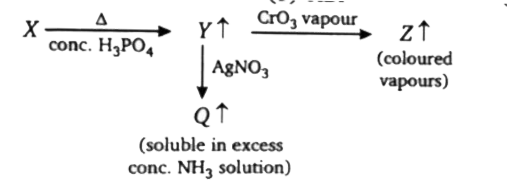Which of the following forms anionic micelles above a certain concentration?
Sodium dodecyl sulphate
Cetyltrimethyl ammonium bromide
Dodecyltrimethyl ammonium chloride
Pyridinium chloride
To determine which of the given compounds forms anionic micelles above a certain concentration, we will analyze each option provided in the question.
1. Identify the Compounds: The question lists four compounds:
- a. Sodium dodecyl sulfate (SDS)
- b. Cetyltrimethylammonium bromide (CTAB)
- c. Dodecyl trimethyl ammonium chloride (DTAC)
- d. Chloride compound (C5H5NHCl)
2. Understand Micelle Formation: Micelles are formed when surfactant molecules aggregate in solution above a certain concentration known as the critical micelle concentration (CMC). The nature of the surfactant (anionic, cationic, or non-ionic) determines the type of micelles formed.
3. Analyze Each Compound:
- Sodium dodecyl sulfate (SDS): This is an anionic surfactant. It has a negatively charged sulfate group and forms anionic micelles when the concentration exceeds the CMC.
- Cetyltrimethylammonium bromide (CTAB): This is a cationic surfactant. It has a positively charged ammonium group and forms cationic micelles, not anionic.
- Dodecyl trimethyl ammonium chloride (DTAC): This is also a cationic surfactant and forms cationic micelles.
- Chloride compound (C5H5NHCl): This is an organic compound but does not behave as a surfactant that forms micelles.
4. Conclusion: Among the options provided, only sodium dodecyl sulfate (SDS) forms anionic micelles above a certain concentration.
Final Answer:
The compound that forms anionic micelles above a certain concentration is Sodium dodecyl sulfate (SDS).
- a. Sodium dodecyl sulfate (SDS)
- b. Cetyltrimethylammonium bromide (CTAB)
- c. Dodecyl trimethyl ammonium chloride (DTAC)
- d. Chloride compound (C5H5NHCl)
- Sodium dodecyl sulfate (SDS): This is an anionic surfactant. It has a negatively charged sulfate group and forms anionic micelles when the concentration exceeds the CMC.
- Cetyltrimethylammonium bromide (CTAB): This is a cationic surfactant. It has a positively charged ammonium group and forms cationic micelles, not anionic.
- Dodecyl trimethyl ammonium chloride (DTAC): This is also a cationic surfactant and forms cationic micelles.
- Chloride compound (C5H5NHCl): This is an organic compound but does not behave as a surfactant that forms micelles.
The compound that forms anionic micelles above a certain concentration is Sodium dodecyl sulfate (SDS).
Topper's Solved these Questions
Similar Questions
Knowledge Check
Which of the following anions is most stabilised?
A B
B C
C DAll have same stability
DAll have same stability
Which of the following oxy anion is metaborate ion ?
View SolutionWhich one of the following forms micelles in aqueous solution above certain concentration?
View SolutionWhich of the following anions is the weakest base ?
View Solution
Which of the following anion cannot be in X?
View Solution
Which of the following anion cannot be in X?
View SolutionWhich of the following does not form micelles in aqueous solution?
View SolutionWhich of the following anion has the smallest radius?
View Solution
